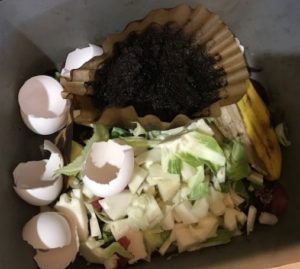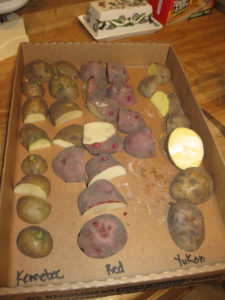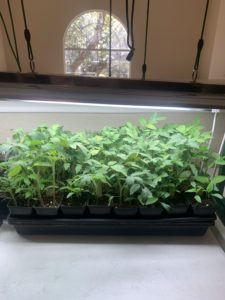Hope Springs Eternal in the February Vegetable Garden
After a series of hard freezes in January, I turn an eye to February in hopes that I can get some things in the ground and get the vegetable garden growing again. I’d better because I bought too many seeds again from all those helpful catalogs that I got in the mail. The trick is, though, to get the timing right because we are not in the frost-free zone yet. Don’t be fooled by those balmy days. Keep a diligent watch on the weather forecast and have your frost protection plan ready!
Since temperatures are starting to warm up, it’s a good idea to start a compost pile if you haven’t already, especially since you’ll have plenty of yard trimmings from the traditional Valentines Day chop. Add leaves, kitchen waste (except meat or milk), coffee grounds, and grass clippings if you have them. Keep the pile moist during the dry spells. If it seems things aren’t happening in the cold weather, sprinkle a few tablespoons of organic fertilizer in the pile and water in well. That little nitrogen boost will help the microbes jump start their repopulation efforts. My favorite nitrogen boost is with coffee grounds that we collect from our neighborhood coffee shop.

Common vegetable table scraps become ‘greens’ for composting.
Here are some other things you can do in the February vegetable garden:
Fertilize
- Send in your soil sample if you haven’t already. (forms available here)
- Use liquid fertilize on cool-season vegetables like leafy greens, brassicas, and onions if needed.
- Fertilize onions 3-4 weeks after planting by sprinkling fertilizer along the outer edge of the row (called side dressing,) about 6-8 inches from the plants, rake it into the soil then water in well. Use 1 cup of fertilizer for 20 feet of plants. Fertilizing onions can make a big difference. Every leaf on an onion plant corresponds to a ring so remember that it is important to grow leaves – the more leaves on the plant the more rings on the bulb.
Water
- Water everything well before a freeze, but avoid overwatering.
- If you planted onions, make sure to water them consistently so that they form nice big bulbs later in the season.
Planting

Cut potatoes into seed pieces with at least two good eyes from which to sprout. Let them dry a week or two before planting in the garden.
- Purchase seed potatoes from a reputable nursery or mail order supplier. Cut large potatoes into small pieces and let cure indoors for a week or two in preparation for planting in mid-February. (See our recommendations here.)
- Hurry to plant sugar snap, snow, or English peas at the beginning of the month. They need 50 to 60 days to start producing before the warm weather settles in for good.
- You can still plant onions too, but don’t dawdle. Onion sets may be hard to find at the nurseries or big box stores.
- Plant seeds for beets, turnips, and carrots later in the month.
- Get your tomatoes or peppers started in the house early this month if you haven’t already.

Tomatoes started earlier this year may be ready for transplanting into larger pots. Start hardening them off toward the end of the month.
Transplanting
- If you planted your own tomato or pepper starts last month, it might be time to move them into a bigger container.
- Move hardy seedlings outdoors late in the month but be ready to protect from freezing temperatures. Harden them off gradually by introducing them to the outside a few hours at a time, gradually building to all day.
- This is the last month to set out cool-season vegetables like cauliflower, broccoli, and cabbage.
Soil
- Take advantage of February’s milder days to prepare your planting areas for spring.
- Do not work the soil if it is wet or you will end up with hard clods when it dries.
- Add a ½ – 1” layer of compost and approximately ½-1 cup of organic garden fertilizer per 10 foot row and lightly mix your amendments into the soil with a spade or a digging fork. This will help get the microbes active and ready for new seedlings or transplants.
Diseases and Pests to Look For
- Snails will be active this month. Pick them off by hand or try some of the other methods recommended in the Grow Green Earth-wise Guide to Snails and Slugs.
- Warm days may trigger populations of beetles and aphids. The best form of pest control is the gardener’s shadow, do regular patrols to step one step ahead.
Maintenance
- Think about letting some brassica plants flower to attract beneficial insects – they love the smaller flowers and the nectar will be welcome so early in the season.
- Remove dead plants that got hit by recent freezes and add them to the compost pile. It helps to reduce habitat for snails and insect pests from your planting beds.
Additional Resources
Watch the Vegetable Gardening in Central Texas Webinar
Recommended Vegetable Varieties for Travis County
Plant Rotations, Successions and Intercropping
Sustainable Food Center Farmers Markets
Monthly Gardening Calendar for Austin and Central Texas
About Sheryl Williams
 Sheryl Williams has been a Travis County Master Gardener since 2010 and currently works as the Horticulture Program Assistant at Texas A&M AgriLife Extension – Travis County. She was introduced to gardening by her mom and grandma and has been an avid vegetable gardener most of her life. Sheryl believes that there is nothing more satisfying than growing and preparing your own food. She likes gardening in Austin year round and concedes that means pulling weeds every day. She practices organic gardening principles and enjoys the challenge of outsmarting garden pests. Occasionally she loses these battles, but doesn’t mind sharing a good meal.
Sheryl Williams has been a Travis County Master Gardener since 2010 and currently works as the Horticulture Program Assistant at Texas A&M AgriLife Extension – Travis County. She was introduced to gardening by her mom and grandma and has been an avid vegetable gardener most of her life. Sheryl believes that there is nothing more satisfying than growing and preparing your own food. She likes gardening in Austin year round and concedes that means pulling weeds every day. She practices organic gardening principles and enjoys the challenge of outsmarting garden pests. Occasionally she loses these battles, but doesn’t mind sharing a good meal.
